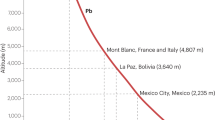Abstract
The effects of chronic exposure to high altitude on the pharmacokinetics of caffeine and cardiogreen (ICG) were examined in eight healthy males (23–35 y) at sea level (SEA) and following 16 days residence at 4300 m (ALT). ICG (0.5 mg · kg−1) was administered as an intravenous bolus and caffeine (4 mg · kg−1) in an orally ingested solution. The concentration of ICG, caffeine, and the primary metabolites of caffeine (MET) were determined in serial blood samples and their pharmacokinetics computed. In comparison to SEA, ALT resulted in a significant decrease in the caffeine half-life (t1/2, 4.7 vs 6.7 h) and area under the curve (2.5 vs 3.7 g · 1−1 · min−1), and increased clearance (117 vs 86 ml · min−1 · 70 kg−1). In ALT the area under the curve of ICG significantly decreased (85 vs 207 mg · 1−1 · min−1) and the volume of distribution and clearance increased (5.2 vs 2.41 and 532 vs 234 ml · min−1 respectively) compared to SEA. There was a significant increase in the AUC ratio of MET to caffeine indicating that either metabolite formation or elimination was increased in ALT. These results demonstrate that in humans, chronic exposure to 4300 m results in the modification of the pharmacokinetics of caffeine and ICG.
Similar content being viewed by others
References
Hultgren HN (1988) High altitude illness. In: Hultgren HN (ed) Management of wilderness and environmental emergencies. Mosby, St. Louis
Wilkerson JA (1985) Medicine for mountaineering, 3rd edn. The Mountaineers. Seattle, Washington
Ritschel WA (1986) Handbook of basic pharmacokinetics, 3rd edn. Drug Intelligence Publications. Hamilton, Illinois
Welling PG (1986) Pharmacokinetics: processes and mathematics. ACS Monograph 185, American Chemical Society, Washington, DC
Jones DP, AW TY, Shan X (1989) Drug metabolism and toxicity during hypoxia. Drug Metab Rev 20:247–260
Kamimori GH, Hoyt RW, Eddington ND, Young PM, Durkot MJ, Forte VA, Brunhart AE, Lugo S, Cymerman A (1995) Effects of chronic hypoxia on the pharmacokinetics of caffeine and cardio-green in micro swine. Aviat Space Environ Med 66:247–250
Dews PB (1984) Caffeine. Springer Berlin Heidelberg, New York, pp 19–100
Bonati M, Latini R, Galletti F, Young JF, Tognoni G, Garattini S (1982) Caffeine disposition in human volunteers after oral administration Clin Pharmacol Ther 32:98–106
Villeneue JP, Huot R, Marleau D, Huet PM (1982) Estimation of hepatic blood flow with indocyanine green: comparison between the continuous infusion and single injection methods. AM J Gastroenterol 77:233–37
Somani SM, Gupta SK, Frank S, Corder CN (1990) Effect of exercise on disposition and pharmacokinetics of drugs. Drug Devel Res 20:251–275
Hoyt RW, Durkot MJ, Kamimori GH, Schoeller DA, Cymerman A (1991) Chronic altitude exposure (4300 m) decreases intracellular and total body water in humans (abstract 55). Proceedings of the 7th International hypoxia symposium, Ontario, Canada
Svensson CK, Edwards DJ, Lalka D, Mauriello PM, Middleton E (1982) Comparison of chromatographic and spectrophotometric analysis of indocyanine green in plasma following administration of multiple doses to humans. J Pharm Sci 71:1305–1306
Daneshmend TK, Jackson L and Roberts CJC (1981) Physiological and pharmacological variability in estimated hepatic blood flow in man. Br J Clin Pharmacol 11:491–496
Meijer DKF, Weert B, Vermeer GA (1988) Pharmacokinetics of biliary excretion in man: indocyanine green. Eur J Clin Pharmacol 35: 295–303
Schumaker RC (1986) PKCALC. Drug Metab Rev 17:331–348
Claybaugh JR, Wade CE, Cucinell SA (1989) Fluid and electrolyte balance and harmonal response to hypoxic environment. In: Claybaugh JR, Wade CE (eds) Hormonal regulation of fluid and electrolytes. Plenum, New York, pp 187–214
Tang-Liu DS, Williams RL, Riegleman S (1983) Disposition of Caffeine and its metabolites in man. J Pharmacol Exp Ther 224:180–185
Costa LE (1990) Hepatic cytochrome P-450 in rats submitted to chronic hypobaric hypoxia. Cell Physiol 28:C654-C659
Blackmon JR, Rowell LB (1986) Hepatic splanchnic function in acutely hypoxemic humans at rest. Am J physiol 251:R887-R892
Rowell LB, Blackmon JR, Kenny MA, Escourru P (1984) Splanchnic vasomotor and metabolic adjustments to hypoxia and exercise in humans. Am J Physiol 247:H251-H258
Rowell LB (1986) Cardiovascular adjustments to hypoxemia. In: Rowell LB (ed) Human circulation: regulation during physical stress. Oxford University Press, Oxford New York, pp 213–256
Ramsoe K, Jarnum S, Preisig R, Tauber J, Tygstrup N, Westergard H (1970) Liver function and blood flow at high altitudes. J Appl Physiol 28:725–727
Author information
Authors and Affiliations
Rights and permissions
About this article
Cite this article
Kamimori, G.H., Brunhart, A.E., Eddington, N.D. et al. Effects of altitude (4300 M) on the pharmacokinetics of caffeine and cardio-green in humans. Eur J Clin Pharmacol 48, 167–170 (1995). https://doi.org/10.1007/BF00192744
Received:
Accepted:
Issue Date:
DOI: https://doi.org/10.1007/BF00192744




